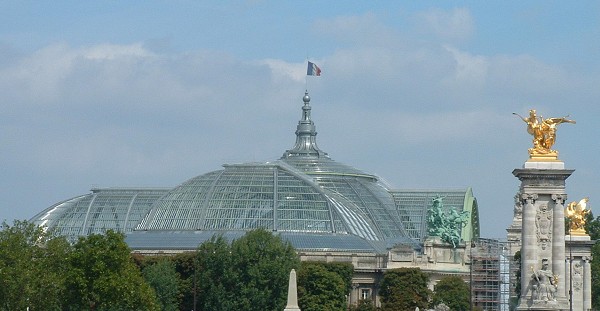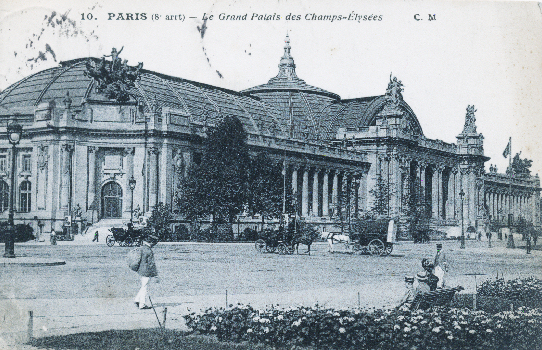
|

the renovated Grand Palais, Paris
Image credit: structurae.de;
photographer: Jacques Mossot.
The Grand Palais
in Paris is the largest existing ironwork and glass structure in the world
since the Crystal Palace in suburban London was burnt down. This glorious
glass-shelled turtle, its main restoration completed, is about to welcome
visitors again after a twelve years closure.

postcard showing the Grand Palais (postmarked
1918)
Together with the Petit Palais (the Little Palace) the Grand
Palais (the Big Palace) was built for the World’s Fair, held in Paris
in 1900, as was the Eiffel Tower. All three were temporary structures, but
once erected there was little willingness to raze them.
Both Palais are made of stone, decorated with coloured mosaics
and sculpted friezes. The Grand Palais supports a huge curved-glass roof with
a Belle Epoque flourish of a pinnacle.
For almost a hundred years, the Grand Palais has been a public
exhibition centre, but has been closed since 1993. Restoration work was done
from 2001 to 2004, at a cost of 72.3 million euro. A second, smaller, stage
of restoration will finish in 2007.
The first stage of the restoration completed, visitors will be able to admire this magnificent structure when
the Palais is reopened as part of the French National
Heritage Weekend. As a bonus, in the restored nave are being shown two
huge globes commissioned and built for Louis XIV, the Sun King.
The French National Heritage Weekend is on the 17th and 18th
September. The Grand Palais will be open from midday to midnight, and will
be host to a visual and sound display [son et lumière] called
“Visible waves”. The display will incorporate the celestial and
terrestial globes made by Coronelli.
The public will walk in a “gallery” that gives the
impression of walking on the restored and illuminated glasswork, thanks to
12,000 electric bulbs and huge inclining mirrors. This will offer visitors
a “poetic vision of the building in a musical universe drawn from the
French heritage of the 17th to 21st centuries, enhanced by natural sounds
of winds, thunderstorms and rain”.
The Grand Palais nave, together with the son
et lumière and the giant globes, will be open at this time for
only a fortnight (17 to 30 September 2005).
Once this display has run its course, the public may still visit
the Grand Palais when it returns to welcoming cultural events. The International
Contemporary Art Fair runs from 5 to 10 October 2005, and later there are
the Haute Couture shows of the fashion houses Dior, Chanel and Yves Saint
Laurent. Antique Fairs and car shows are also scheduled.
the
restoration
- Consolidating and reinforcing the foundations – previously constituting
3400 oak piles, these have been replaced by concrete pillars down to 12
metres to reach solid limestone beneath the silt of -he river Seine
- The metal framework of the nave was completely repaired and renewed
- The glasswork made transparent once more, by replacing the glass
- Roof repaired and recovered
- Restoration of the large statues at the corners of the building’s
front: horses galloping, leaping forwards. Sculpted by Georges Récipon,
the one near the Seine represents Triumphant Harmony over Discord, while
that facing the Champs-Elysées, Immortality outstripping Time. The
statues were dismantled and transported by road to the Perigord (Dordogne)
for the restoration work.
- Mosaics completed repaired and restored, with the 1200 different colours
in the designs carefully matched. Once again, the previous ages of culture
and arts are clearly pictured - the Greeks, Romans, the Renaissance.
- Note that restoration of the Petit Palais will start in December 2005.
Some statistics
- Steel framework: 8,500 tonnes, compared with 8,000 tonnes for the Eiffel
Tour
- Glass area: 15,000 m²
- Roof: 5,200 m² galvanised iron roofing (‘zinc’)
- Restoration: first stage 2001 to 2004, cost 72.3 million euro
second stage predicted finish 2007, cost 29.06 million euro
(total restoration cost: 101.36 million euro).
the globes of Louis
XIV

The two globes made for Louis XIV
Image credit: National Bibliotheque de France
Most people have seen, or even used, the dinky little globes of about 20
or 25 cm (8 or 10 inch) diameter. There may even have been a 30 or 40 cm (12
or 16 inch) globe in school.
The globes that are being displayed in the Grand Palais, made for King Louis
XIV [the fourteenth, 14th], are 384 cm in diameter; that is, almost four metres
in diameter - ten times the diameter of that big 40 cm/16 inch globe at school.
One is a terrestial globe, showing the world as it was known in the late 17th
century, while the other is a celestial globe, shows stars and their constellations.
“Vincenzo Coronelli, born in Venice in 1650, was a Franciscan monk
as well as a cartographer. One of his most significant accomplishments was
the pair of giant globes (completed in 1680) which he produced on commission
for King Louis XIV of France. Each one measured almost four metres in diameter,
and had a doorway through which people could enter
to observe the globe from the interior. About thirty people could fit inside
each one.
“The globes were transported to Marly and not Versailles, and remained
there for a long time.” [For this reason, the globes are known as
the Marly globes.]
[Quoted from bbc.co.uk]
The last time the public saw these globes was 25 years ago in the Pompidou
Centre; and before that, 100 years ago.
The two globes were made in 1681 and 1683. When their display in the Grand
Palais has ended, they will also be restored, to be shown in the National
Library of France during 2006.

a sheet map made by Vincenzo Coronelli,
also used on the Marly terrestial globe.
Image credit: cartaweb
A map of the known world, together with illustrations of different human
peoples and crafts, such as whaling, decorated the Terrestial globe . One
notable part of the map of North America showed California as a separate moon-crescent
island, while another part showed the mouth of the Mississippi river displaced.
Whether this last was a cartographer’s error, or a ploy by Louis XIV
to confuse those wishing to invade his colony across the Atlantic, is not
known. (The colony is now known as Louisiana, Louis XIV sold it to the Americans
for $US 11,250,000.)
construction
of the globes
measurements:
- diameter: 3.84 m
- circumference: 11.6 m
- weight: 1 500 kg
structure
- arched and tapered wood struts; 3 m long, approx. 10 cm wide at the equator
- each hemisphere contained of 120 struts
- the wood was covered by a shell of plaster
- on which was glued heavy canvas
- a layer of filler followed
- then several other fine, plastered canvases
- with a last layer of canvas prepared as a painting support.
some facts and
history
- Globes constructed in 1681 and 1683
- Vincenzo Corneilli estimated that the globes cost 100 000 pounds to make,
he received 46 000 pounds from Cardinal Duke d’Estrée [the
French ambassador to Rome] at the end of 1683. However, Corneilli was also
able to use the wealth of ducumentation generated to produce his engraved
atlas.
- Three of the craftsmen who worked on the globes were
- Giambattista Moro, catographer and worker
- Perronel, draughtsman
- Jean-Baptiste Corneille, painter of the celestial globe
- It is said that it was the idea of Colbert, advisor to Louis XIV, to have
these globes made for the king. However, Colbert died in 1683, the year
that the globes were finished. This perhaps why the globes were never installed
in the Chateau de Versailles, although that was their intended destination.
- By the end of 1704, the globes were installed at the Chateau de Marly,
in Yvelines.
- In 1715, Louis XIV decided to transfer the globes to Paris, which was
done by 1722, the globes being part of a special Room of Globes in the Library
of the King. This room was open to the public from 1872 until it was closed
and then transformed into a reading room in 1900.
- From 1901 to 1980, the globes were kept in packing cases in the Orangery
at Versailles.
- They were taken out in 1980 for an exhibition on cartography at the Pompidou
Centre, Paris, to be seen by 200,000 people. The globes were then reboxed
up and warehoused at La Villette.
- The globes are now to be integrated into a museum complex at Marly-le-Roi,Yvelines,
due to be completed in 2005, together with many other publically owned works
dumped at Marly since the revolution.
- The Library of the King became, in due course, the National Library of
France.
end notes
- The French National Heritage Days (les jours de
patrimoine nationale) are part of the 22nd version of Europe Heritage Days,
a now annual, EU-wide, event.
|





















